Electricity and energy sources
Electricity and energy sources
 electricity
electricity
search for electricity The source of electricity is one of the most important sources that we cannot dispense with due to its importance in human life after the start of the industrial revolution at the global level. With the beginning of the twentieth century, productivity began to increase Electric energy with the best efficiency for use in many different fields and sectors.
Here we will put in your hands a search for electricity to include the definition of electricity, its uses and its sources.
history of electricity
The story of electricity began in ancient times when the Greek scientist Thales studied the phenomenon of the amber rod attracting the feathers of birds after rubbing it. where he noticed that it was beginning to acquire the properties of a magnet, They called it in English ( electricity ), which was derived from the ancient Latin word (elektron), which means amber. In the Arabic language, this phenomenon is called electricity, directly related to amber.
definition of electricity
represents electricity Electricity) is one of the main sources that we rely on completely in our daily lives to support the economy, industry, public services, information and other various sectors.
The development of electricity began after the discovery of the phenomenon of static electricity. Where scientists have conducted research during the past 500 years focusing on this phenomenon in its entirety, Although we can’t see it with the naked eye, But it can be measured, generated to potential, transmitted through conductors, and then consumed.
types of electricity
Electricity arises as a result of the accumulation or flow of a group of charges through a conductor. These charges are called current and are measured in amperes. Electricity is divided into two main parts:
Static electricity: It is called by this name because it generates natural charges that accumulate on the surrounding bodies as a result of friction and the forces of attraction and repulsion. An example is: When taking off sweaters or when opening nylons, They are charges that do not move through copper conductors.
moving electricity: It is called by this name because it originates from generating stations of all kinds to generate an electric current that passes through a copper conductor. Electric current is defined as the rate of flow of electrons across the surface of a conductor.
Types of moving electricity
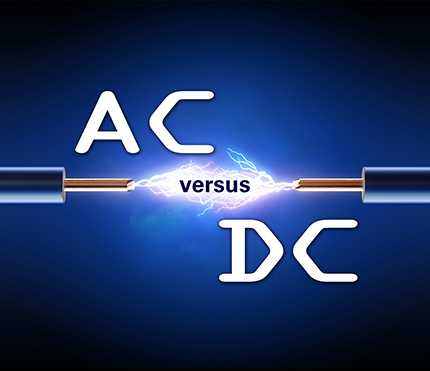 There are two types of electricity that can be generated:
There are two types of electricity that can be generated:
Alternating Current (AC): The current is generated in the form of a sine wave by changing the value and direction during one second 50 or 60 times, depending on the value of the frequency, Hz. Therefore, we say that it is a non-polarized source, that is, it does not have a positive pole and a negative pole. It is used in operating most electrical appliances (domestic, commercial, industrial and office).
Direct current (DC): The current is generated in a linear form without changing the value and direction, Where the current flows in one direction with the value of the voltage constant without any change.
The DC source is polarized with a positive pole and a negative pole. It is used to operate direct current loads and to charge electric batteries and mobile phones of all kinds. And most devices that contain internal electronic boards, such as monitors and computers.
Methods of generating electricity in terms of its production
The methods of generating electricity vary according to the type of source adopted, and these sources include:
- sustainable energy: It is the energy generated by natural resources such as the sun’s energy, wind energy, hydroelectric energy, dam energy, and tidal energy.
- Jealousy Energy Renewed: It is the energy resulting from unnatural sources such as fossil fuels such as coal, oil and gas. which are extracted from the ground, It is also called unclean energy because it produces emissions and global warming is harmful to the environment and human life.
Electricity uses
The source of electricity is used in all sectors, including:
- health sector.
- Engineering sector.
- agriculture sector.
- space sector.
- Transport and Communications Sector.
- industry sector.
- trade sector.
- Military sector.
- Education sector.
- in homes.
What is electrical energy and how is it generated?
What is electrical energy
What is electrical energy and how is it generated? The electrical energy (in English: Electrical energy is one of the most important basic elements that benefit us in our daily life, and we obtain it from natural resources to meet our needs in various fields such as operating all household, commercial and industrial appliances.
There are various sources that work to generate electric power, namely non-renewable (conventional) and (non-conventional) sources of renewable energy, through which we obtain the electrical energy needed to supply electricity to residential homes, commercial buildings and industrial areas.
Follow this article with us, what is electrical energy and how to generate it.
Contents
Definition of electrical energy
Energy can be defined (in English: Energy) is the ability to do work or perform a job. It is divided into two types: potential energy and kinetic energy. It has many different and varied forms that are easy to convert into energy. Electric energy is a secondary source because it cannot be extracted from the ground or modified, unlike sources derived from primary energy such as solar energy, wind energy, coal, oil and natural gas.
Electrical energy can also be defined as the amount of work done in the electrical circuit necessary to move charges or electrons during a certain period of time. This movement is called electric current.
electrical energy storage
Electric energy charges can be stored through storage methods such as batteries or capacitors to be used in many applications. One of its most famous uses is to store the energy produced from solar cell panels and store it in batteries after regulating them in accordance with their voltage. And also in generating energy through the dynamo of the car, regulating it and storing it in the battery to take advantage of it in starting the car and supplying the lights with energy.
Sources of electric power generation
There are many different sources that help in generating electrical energy, the most important of which are:
- Renewable energy sources: It depends on the energy of the sun, wind energy, tidal energy, waves and hydroelectric energy.
- Non-renewable energy sources: It relies on fossil fuel sources (coal, natural gas, and crude oil) and nuclear energy.
Methods of generating electric power
The process of generating electric power is carried out in several ways, namely:
Electricity generation from thermal plants, It is divided into:
- Steam power stations: The idea of its work depends on burning fuel to convert water into steam to drive a turbine connected to the generator drive shaft to produce electrical energy.
- Gas Power Plants: The idea of its work depends on mixing air with fuel to produce gases with high pressure and temperature that work on managing the tobin connected with the generator drive shaft to produce electrical energy.
- Gas and steam generating stations together: The idea of \u200b\u200btheir work depends mainly on the generation of electric power from the gas station. The waste combustion gases are utilized in heating the water and converting it into steam for use in the management of the turbines of the units of the steam stations.
generation of electric power from renewable sources, It is divided into:
- solar energy: The idea of its work is based on absorbing photons of sunlight and converting them into electrical electrons by solar cells.
- Wind Energy: The idea of its work depends on the exploitation of winds in managing its windmills to obtain electrical energy under some of the technologies designed for this process.
- Hydropower: The idea of her work depends on building dams in rivers to raise the water level in order to obtain a strong water stream such as a waterfall to operate or manage the turbine.
- wave energy: The idea of her work depends on taking advantage of the movement of waves and harnessing them in mechanical works to benefit from them in generating electrical energy.
- Tidal Energy: The idea of her work is based on converting the movement of tides in the oceans into electrical energy.
Advantages of electric power
- They can be moved far to supply electricity to areas.
- It can be converted from AC to DC easily.
- It does not affect the environment and the surrounding atmosphere.
- Its transmission efficiency is high.
- Its ability to operate all electrical appliances (domestic, commercial and industrial).
- It can be produced by sun, wind or water.
 The main sources of electrical energy
The main sources of electrical energy
The main sources of electrical energy
The main sources of electrical energy, The methods of generating electrical energy mainly depend on converting energy sources into electrical energy in the form of alternating current or direct current, such as solar cells. Which we use in our daily lives to operate loads of electrical devices of all kinds.
Electric energy sources are classified according to their nature into two types: Non-renewable energy sources (conventional), and renewable energy sources, So, follow this article with us to learn more details about the most important sources of electrical energy and its types.
What are the sources of electrical energy
There are many sources of electrical energy according to their types:
Non-renewable energy sources (conventional): It includes nuclear energy and fossil fuels such as coal and crude oil.
Renewable energy sources (unconventional): Sources include sun, wind, and water.
coal
It is considered the source of coal (in English: Coal) from one of the sources of fossil fuels that are extracted from the ground, and it is also known as thermal coal, and it is usually black or brown in color. It also burns quickly. It is used as a source for heating homes and some industrial fields. It is also used in power plants as a raw source by burning it inside a furnace to convert water into steam to drive a turbine.
coal
Crude Oil
Classification of oil (in English: crude oil) from a conventional energy source, which are extracted from geological formations located in the ground, It undergoes a refining process after its extraction for use in various fields. It is used as a raw source in thermal power plants.
oil
Nuclear Energy
It is one of the traditional energy sources and exploits nuclear energy. Nuclear power) in the generation of electrical energy by producing enormous heat energy that evaporates water by using nuclear fission of uranium atoms, The electric energy produced by it constitutes 14% at the global level.
Nuclear Energy
solar energy
Solar energy (in English: solar energy) is one of the renewable energy sources, It mainly depends on converting sunlight into electrical energy through solar cells. In addition, thermal energy can be generated, which is used to heat water, Where many believe that the source of solar energy is on the way to prosperity in some countries of the world, This makes it one of the most important sources of electrical energy in the future.
solar energy
Wind Energy
Wind energy (in English: Wind Energy) from one of the renewable energy sources, Its principle of operation relies on converting the kinetic energy resulting from the movement of the wind into electrical energy through windmills. It is used as an alternative source of fossil fuels.
Wind Energy
hydroelectricity
Hydroelectricity is classified as: Hydroelectric) is a renewable energy source. The principle of its work is based on building dams to raise the water level to exploit the movement of water flow to move the turbine to produce kinetic energy to transfer it to electrical energy by moving the electric generator. There are some countries in the world that have built dam stations to produce electricity in order to reduce dependence on thermal stations.
hydroelectricity
Damage and dangers of electrical energy
Despite the advantages of electricity used in our daily lives, it poses a threat to human life. Among these risks are:
- The risk of losing sight as a result of the use of welding equipment, which depends on the electric arc in its work.
- Overheating or overheating of the cables or conductors carrying electrical current may cause a fire.
- Placing flammable or explosive materials near sources of electricity without any insulators, It means a big fire or explosion.
- If a person is exposed to an electric current of less than 15 milliamperes, Burns and muscle contraction occur, in addition to the possibility of paralysis of the rib cage.
- If exposed to an electric current of 15 mA or more, There is a possibility of inevitable death by stopping the heartbeat and the appearance of burns inside the body.
With scientific and technological progress, Renewable energy plants are on the increase at the global level for many reasons, most notably what has been confirmed that the cost of generating electricity from solar and wind energy has become more economic than fossil fuel sources such as coal and gas. It also reduced environmental pollution, Here, we have provided you with information about the most important sources of electrical energy.
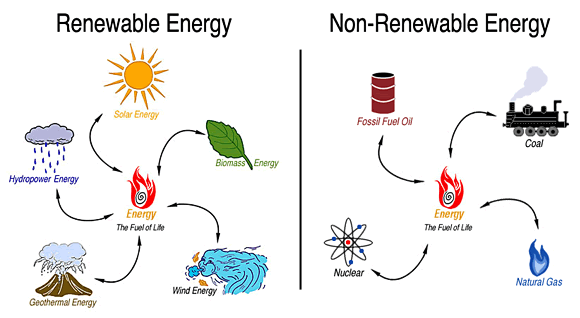 The difference between renewable and non-renewable energy
The difference between renewable and non-renewable energy
The difference between renewable and non-renewable energy
The difference between renewable and non-renewable energy, Uses renewable and non-renewable energy sources to provide electrical energy, Renewable energy sources rely on natural resources such as the sun and wind to generate electric power. While non-renewable energy sources depend on resources extracted from the ground, such as fossil fuels and nuclear energy.
Follow this article with us to learn more details about the difference between renewable and non-renewable energy in terms of their sources and the advantages and disadvantages of each.
Types of energy sources
Energy is classified into two sources:
- sustainable energy: It includes solar energy, wind energy, water energy, waves and ground energy, It was called by this name because it is renewable, sustainable and impermeable.
- Non-renewable energy: They include oil, coal, natural gas and chemicals, It was called by this name because it is not sustainable and requires long periods of time to compensate.
sustainable energy
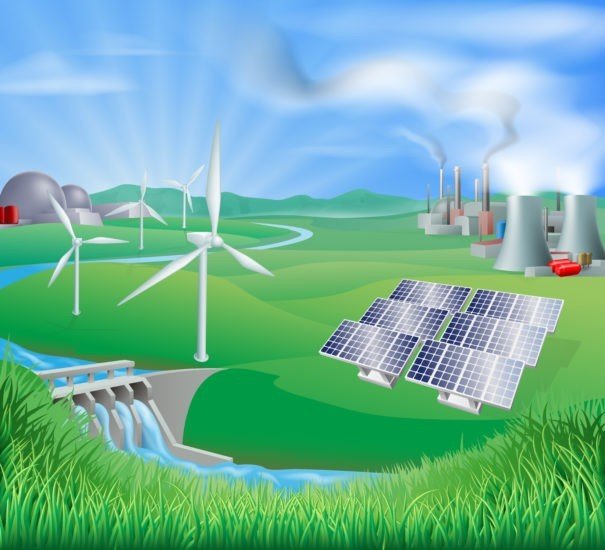 Renewable energy is defined as energy that is derived from natural resource sources and is replenished over and over again. There are a variety of renewable (clean) energy sources, including solar energy, wind energy, and hydropower, hydro power, bio energy and thermal energy, and tidal energy.
Renewable energy is defined as energy that is derived from natural resource sources and is replenished over and over again. There are a variety of renewable (clean) energy sources, including solar energy, wind energy, and hydropower, hydro power, bio energy and thermal energy, and tidal energy.
The most prominent sources that are widely used in developed and some developing countries are solar energy and wind energy, in addition to hydroelectric energy produced by building dams.
Renewable energy advantages
- They depend on natural resources that are replenished quickly, such as the sun, wind and water.
- Sustainable and imperishable energy.
- It does not depend on fossil fuel sources for its electrical energy production.
- It produces free energy, unlike traditional plants that need fossil fuel sources on a daily basis.
- Its maintenance cost is low.
- It produces huge and unlimited amounts of energy.
- Do not consume any kind of fossil fuel sources.
- clean and environmentally friendly energy, As it does not cause any harmful emissions to the environment such as carbon dioxide.
- It is not affected by wars, conflicts or strikes, unlike non-renewable energy sources.
Comparison between renewable energy and non-renewable energy
Disadvantages of renewable energy
- The high cost of building renewable energy plants.
- Affected by the fluctuations of the weather of the seasons and changing climatic conditions.
- The solar energy source needs large amounts of batteries to store energy for use at night.
- Renewable energy sources need large areas such as solar energy and wind energy.
- The efficiency of solar electricity generation is low and in the development stage.
non-renewable energy
Non-renewable energy is defined as the energy that is derived from the sources of resources extracted from the earth’s interior in addition to the uranium radioactive used in nuclear energy. There are a variety of non-renewable energy sources, including coal, crude oil, natural gas and nuclear energy.
Where developed countries and some developing countries began to dispense with some gas and coal stations because they are polluting and unprofitable and require large amounts of fossil fuels on a daily basis. And resorting to building solar and wind energy plants to produce clean and free energy based on natural sources.
Non-renewable energy sources
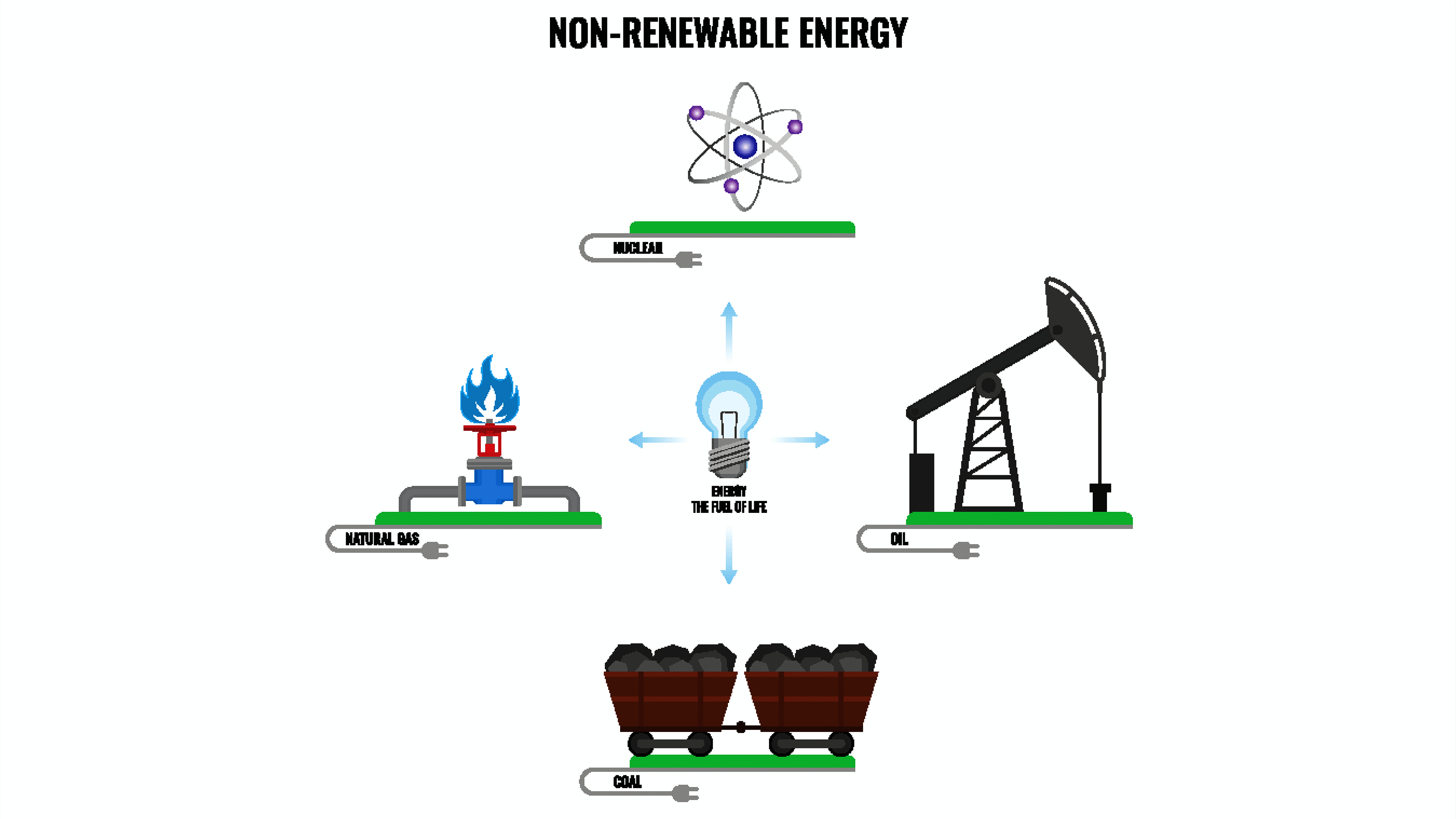 Non-renewable energy sources
Non-renewable energy sources
non-renewable energy sources, Non-renewable energy sources are one of the resources that are extracted from the ground to be used in several matters, such as generating electric power.
Non-renewable energy sources called fossil fuels were formed over hundreds of years and are available in limited quantities that are not sustainable and cannot be renewed within a short period.
Follow this article with us to learn more details about non-renewable energy sources.
Define non-renewable energy sources
It is one of the energy sources that have been discovered and extracted from the earth’s interior to meet the needs of the universe. Where it formed in the earth’s interior in similar ways during a period of more than 200 million years, There are two categories of this type, namely fossil fuels and nuclear fuels.
Types of non-renewable energy sources
There are several non-renewable energy sources, which are:
- Coal.
- Crude Oil.
- Natural gas.
- Nuclear Energy.
Coal
It is one of the most important sources of fossil fuels due to its combustibility for use in power generation. And it is in the form of a sedimentary rock ore consisting of carbon and hydrocarbons in black or dark brown color. Where it formed in the ground of dead plants during millions of years under pressure, heat and lack of air. It is used for energy production due to its low cost. But it pollutes the environment because it produces gases when burned.
Crude oil
Crude oil consists of a mixture of organic compounds, consisting mainly of hydrocarbons, It is extracted from reservoirs and basins buried within sedimentary rocks underground. Saudi Arabia is the largest country in the world in terms of oil reserves.
Oil sources are used in the transportation sector, petrochemical industries, plastics, synthetic rubber and other uses.
natural gas
It is considered one of the important fossil energy sources due to its frequent use in many fields. It is extracted from the ground. It consists of a mixture of compounds, the most important of which is methane. It is processed for use as fuel. It is used in power plants or in domestic uses such as heating, cooking and water heating, or in industries that require intensive fuels such as cement.
Nuclear energy
It is one of the non-renewable energy sources due to its use of the radioactive element uranium, which is used to produce large amounts of heat when it decomposes to form steam. This steam is used to drive turbines to generate electricity. As the element uranium is radioactive and harmful to the environment.
Non-renewable energy sources
Advantages of non-renewable energy sources
- Not affected by weather factors.
- Provides continuous and uninterrupted power.
- The emergence of some technologies that reduce carbon dioxide emissions and store it in the ground instead of releasing it into the atmosphere.
Disadvantages of non-renewable energy sources
- Unsustainable and permeable.
- The process of extracting it and transporting it causes environmental damage on a large scale.
- It needs expensive equipment to extract fossil fuel sources.
- It produces carbon dioxide.
Advantages of non-renewable energy
- Provides continuous power and is not affected by weather fluctuations.
- You do not need large areas in order to build non-renewable energy plants.
- The emergence of technologies that reduce the emission of carbon dioxide in the atmosphere and store it in the ground.
Disadvantages of non-renewable energy
- It generates carbon dioxide gas.
- It increases global warming.
- Energy is unsustainable and needs long periods of time to be replenished.
- Unclean energy and harmful to the environment and society.
- Its low efficiency due to the presence of losses in conventional stations.
- High maintenance costs.
- It relies on energy to be generated from fossil sources. This is what makes it free energy.
The difference between renewable and non-renewable energy
| sustainable energy | non-renewable energy |
| It depends on natural resources such as sun, wind and water | It relies on resources extracted from the ground such as fossil fuels and nuclear energy |
| Clean, pure, sustainable or zero energy | Environmentally harmful, unsustainable and exhaustible energy |
| Produces free energy after being built | Produces energy based on the availability of fossil fuels such as natural gas, oil and coal |
| Not affected by economic and political conditions | Affected by economic and political conditions |
| Low maintenance costs | High maintenance costs |
| You need simple equipment with the possibility of installing a solar system for the home | You need gas, nuclear, or steam plants to generate electric power |
| You need large areas to install solar panels, to install windmills, or to build dams | It needs a small space compared to renewable energy plants |
We have been content with explaining the difference between renewable and non-renewable energy in terms of the definition of each, with the advantages and disadvantages of each energy source.
 electrical power sources
electrical power sources
electrical power sources
electrical power sources, know energy Energy) as one of the basic ingredients that we rely on in our daily activities, There are many forms of energy, the most famous of which are electrical, kinetic, radioactive, and atomic energy. Thermal, optical and dynamic.
Follow this article with us to learn more details about the types of electrical energy sources.
What are the sources of electrical energy
They are the sources that transform kinetic, solar, wind or water energy into electrical energy for use in various areas of our daily life.
Where the process of producing electrical energy is carried out through steam, gas or nuclear power plants. Or by relying on natural energy resources such as the sun, wind or water.
Classification of electrical energy sources
Electric power sources are classified into two main categories:
- Conventional Energy Sources: They are the sources that are derived from the ground and cannot be replaced within a short period of time, such as nuclear energy sources and fossil fuels that are used in steam and gas stations for power generation.
- Unconventional energy sources: It is also called renewable energy. Renewable energy is defined as the sources that are renewable and available always or at periods that depend on the availability of the source of the sun and wind.
electric power plants
Generating stations are built in the form of plants that run on steam, natural gas, nuclear energy and other energy sources to produce electrical energy to provide electricity to meet public needs.
Methods of generating electric power
There are several ways to generate electrical energy and they are divided into:
- Electricity generation using traditional sources, including:
- Steam stations.
- gas stations.
- Both steam and gas stations.
- nuclear plants.
- Small and medium generators.
- Generating electric power using unconventional sources, including:
- Photovoltaic cells ( solar panels ).
- Wind power plants.
- Hydroelectric stations (construction of dams on river channels).
- Tidal Energy.
The importance of using traditional energy sources
The importance of using traditional electric energy sources lies in the fact that they do not need fossil fuels during their production of energy. In addition to the possibility of adopting it as a safe and harmless source.
Despite the low efficiency of non-conventional energy conversion such as photovoltaic cells, which reaches only 24%, Wind turbines only reach 35% when converted to electrical energy.
However, there are some studies indicating that the exploitation of solar energy will reduce the production costs of electrical energy compared to traditional energy sources that use gas and oil by a large difference in the future, according to the prediction of the German Fraunhofer Institute for the year 2050.
Electricity and energy sources
We are pleased to have you visit our pages on social networking sites, where we publish exclusive offers on our website.
Our Facebook page here .
Our Twitter account is here .


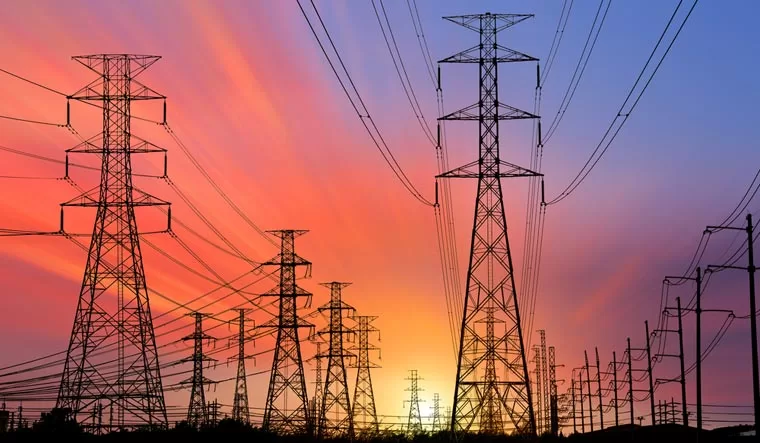










Leave a Reply
You must be logged in to post a comment.